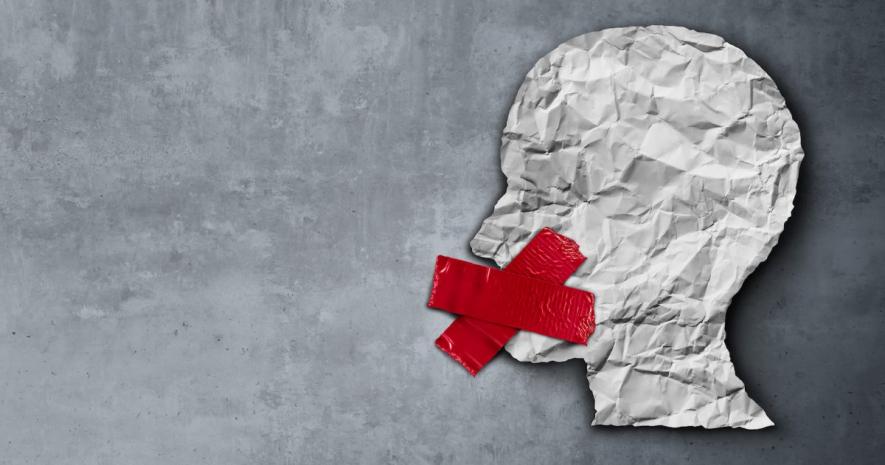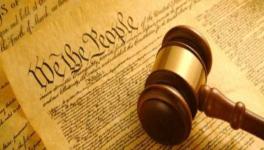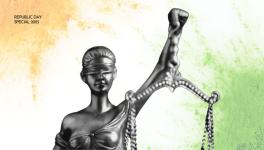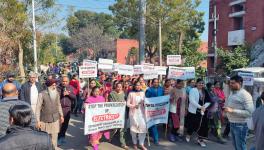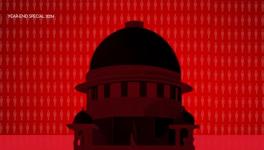Lurking behind the Supreme Court’s endorsement of liberal free speech values while striking down Section 66A of the IT Act, is a continuation of the colonial structures of speech regulation that enables a democratically-constituted government to resist attacks on its legitimacy.
—–
On March 24, 2015, the Supreme Court in Shreya Singhal versus Union of India famously struck down Section 66A (punishment for sending offensive messages through communication service, etc.) of the Information Technology Act, 2000 (‘IT Act’) as unconstitutional for its disproportionate impact on the right to free speech under Article 19(1)(a) of the Constitution. This provision penalized “grossly offensive”, “annoying”, “inconvenient” and “insulting” speech online, and several arrests were made under it targeting political opposition.
The court’s ruling in Shreya Singhal has been lauded for making significant advancement in the free speech jurisprudence of India, and for extending the right to free speech into the online space. Lawyer and constitutional law scholar Gautam Bhatia went so far as to write that the free speech jurisprudence of India found its soul again through Shreya Singhal.
There are good enough reasons for the jubilation and extolment that had followed the judgment. While striking down section 66A, the court advanced considerable speech-protecting principles. It made a distinction between speech that amounts to only discussion or advocacy and speech that amounts to incitement to violence, and insisted on proximity between the speech and the threatened act for restrictions to be placed on the speech. Further, it puts the burden on the State to prove that a speech incited imminent lawless action.
While the challenge against section 66A and the court’s ruling on it hogged most of the limelight, it is often glossed over that the case also involved a constitutional challenge against Sections 69A (power to issue directions for blocking for public access of any information through any computer resource) and 79 (exemption from liability of intermediary in certain cases) of the IT Act, which were ultimately upheld by the court. These sections give enormous power to the government to direct internet intermediaries such as social media platforms to block public access to and take-down certain content from their platforms. Saved by the Supreme Court, these sections have turned today into potent weapons in the hands of the government to stifle the speech of dissidents.
The Executive is emboldened to act without giving reasons or justification for its actions, even if it restricts the rights and liberties of the citizens. In a culture of authority, individuals lose their status as rights-bearing citizens and become subjects again.
After the completion of seven years of Shreya Singhal, I revisit this judgment to critically examine its real legacy for the free speech jurisprudence of India. I aim to do this by situating the court’s ruling, particularly on sections 69A and 79, in the historical context of the First Amendment to the Indian Constitution, and by examining what the judgment means for the relation between the State and the citizen. The primary argument that I make here is that lurking behind the court’s endorsement of liberal free speech values while striking down section 66A, is a continuation of the colonial structures of speech regulation that enables a democratically-constituted government to resist attacks on its legitimacy.
Also read: Recalling why Section 66A of IT Act was struck down
States of exception and the judicial approach in India
In his book ‘The Transformative Constitution: A Radical Biography in Nine Acts’, after lauding Shreya Singhal for proscribing only speech that constitutes ‘incitement to violence’, Bhatia poses a fundamental question – how can the jurisprudence evolved in Shreya Singhal co-exist with laws like Section 124A (sedition) of the Indian Penal Code (‘IPC’) and the Unlawful Activities (Prevention) Act (‘UAPA’), which criminalize mere questioning of the sovereignty of India and being a member of particular organizations? He answers this question by observing that “when it comes to exceptional situations, the Court has honoured its civil rights jurisprudence far more in breach than in observance”.
When it came to considering the constitutional validity of Sections 69A and 79, and the justiciability of the State’s power to block public access to information, the Supreme Court was reluctant to apply its liberal free speech principles that it enunciated while striking down Section 66A. Instead, it was comfortable in trusting the State with such an unlimited power to block access to information.
The exceptional situations or ‘states of exception’ that he refers to are Emergency, preventive detention, and anti-terrorism laws. He then goes on to identify four features of the Indian judiciary’s approach to free speech claims in ‘states of exception’. They are: (i) executive supremacy, (ii) denial of remedies, (iii) jurisdiction of suspicion, and (iv) salus populi suprema lex (welfare of the people is the supreme law).
I briefly explain each of them below:
Under ordinary circumstances, it is a cardinal principle of our constitutional order that the executive justifies and gives reasons for its actions that curtail the liberties of citizens, and the judiciary scrutinizes the reasons to assess their validity. But in ‘states of exception’, this principle is reversed, and the executive decides when a ‘state of exception’ comes into existence and what the rights of the citizens in such a state will be. The judiciary accepts this executive supremacy by displaying “good faith and trust in the benevolent motives of the government”, as per Bhatia, and by discarding any concerns about the possibility of State excesses.
Another feature of a state of exception is the practical denial of remedies against the excesses of the executive. The judiciary also acquiesces to this non-existence of remedies by employing the ‘larger public interest’ rhetoric or by refusing to interpret the law in favour of providing even the rudimentary remedy that exists in the law. Lack of recourse to enforcement of fundamental rights during Emergency, and the humungous difficulty in securing bail under anti-terrorism laws are good examples of this, writes Bhatia.
Both Sections 69A and 79 have been designed for controlling, rather than promoting, free and open discussion in the public sphere. By refusing to strike down these sections, the court’s reasoning resembles the judicial approach to free speech claims during states of exceptions such as Emergency and preventive detention, as it entrusted the control over the public sphere with the government with little to no safeguards against its abuse.
Jurisdiction of suspicion means that in states of exception, the State curtails the liberty of citizens upon the mere subjective belief of the executive authority that a person’s act or speech might be a threat in the future. As Bhatia observes, it “eschews any requirement of proximity between the perceived threat and the actual instance of law-breaking”. Courts are reluctant and sometimes incapacitated to scrutinize the merit of this subjective satisfaction as the factual foundations of such satisfaction are kept beyond the purview of judicial review.
Finally, the executive’s action in a state of exception is always justified by invoking salus populi suprema lex. The courts also agree that the State knows what is good for the citizens, and that it may be necessary sometimes to take drastic measures in extraordinary times, notes Bhatia.
He argues that these four features of the judiciary’s approach endorse a ‘culture of authority’, that is, the executive is emboldened to act without giving reasons or justification for its actions, even if it restricts the rights and liberties of the citizens. In a culture of authority, individuals lose their status as rights-bearing citizens and become subjects again, he claims.
Also read: Twitter versus government: The gravamen of restricted free speech
Spectre of culture of authority in Shreya Singhal
I argue that the jurisprudence evolved in Shreya Singhal, instead of being contradictory to the jurisprudence that sustains laws like sedition and UAPA, as Bhatia argues, has all the features of the judicial approach to ‘states of exception’ that produces and validates these laws. When it came to considering the constitutional validity of sections 69A and 79, and the justiciability of the State’s power to block public access to information, the court was reluctant to apply its liberal free speech principles that it enunciated while striking down section 66A. Instead, it was comfortable in trusting the State with such an unlimited power to block access to information. By doing so, the court endorsed a ‘culture of authority’, and facilitated the perpetuation of a state of exception such that it is no longer clear what is normal and what the exception in the digital space is.
To explain my argument, I break down the court’s reasoning for upholding sections 69A and 79, and show how it exudes some or all of the features that Bhatia identified as characterizing the judiciary’s approach in ‘states of exception’.
(i) Section 69A
Section 69A empowers the Union Government to issue directions for blocking of information from public access on the grounds of sovereignty and integrity of India, defence of India, security of the State, friendly relations with foreign States, public order or for preventing incitement to the commission of certain cognizable offence. The section has to be read along with the Information Technology (Procedure and Safeguards for Blocking for Access of Information by Public) Rules, 2009. The Rules empowers certain officers of the Union Government to receive complaints, and to decide whether any particular information on the internet is prejudicial to the grounds enumerated above and if so found, to issue blocking directions.
While upholding the constitutionality of section 69A, one of the factors that the court weighed in its favour was that the section allowed blocking to be done only when the Union Government was satisfied that it was necessary to do so. Further, the court observed: “Merely because certain additional safeguards… are not available does not make the Rules constitutionally infirm.” By not requiring any safeguards against the enormous power of the State in deciding whether any content is to be blocked under section 69A, the court acquiesced to the executive supremacy inbuilt in the section. This is a classic example of excessive judicial deference shown to the subjective satisfaction of the State, and a trust in the benevolent intentions of the State.
Another reason put forward by the court to uphold section 69A was that since the grounds on which the government can issue blocking orders are correlative to the grounds on which speech can be restricted under Article 19(2) of the Constitution, it does not violate the fundamental right to speech under Article 19(1)(a). However, as advocate and legal researcher Alok Prasanna Kumar points out, by simply importing some of the grounds mentioned in Article 19(2) without any further explanation as to when a speech will violate these grounds, section 69A, read with its Rules, leaves the interpretation of the grounds like security of State and public order, among others, to Union Government executives who are empowered to issue blocking orders upon their mere subjective satisfaction. This establishes a jurisdiction of suspicion in the digital space, where our speech can be blocked if the executive sees even a remotest possibility of it leading to an undesirable act.
The first amendment to the Constitution provided the constitutional architecture for the validation of a whole host of coercive and repressive legislation.
Yet another reason why the court upheld section 69A and its allied Rules is that since the reasons are to be recorded in writing in the blocking order, they may be assailed before the court by the person aggrieved. But the court seems to have overlooked the fact that Rules 16 of the Rules require the blocking requests and the decision taken thereon to be kept confidential. Hence, the Rules deny recourse to remedy against a blocking order of the government. By not giving sufficient consideration to this fact, the court acquiesced to this non-existence of remedy.
Also read: Online censorship: Government’s favourite pastime activity
(ii) Section 79
Section 79 confers on internet intermediaries immunity from liability for the third party content that they host, provided they take down content upon receiving actual knowledge of the unlawful nature of content. This section was challenged on the ground that it allows private entities like intermediaries to exercise their own judgment about the unlawfulness of speech.
But instead of striking down the section as unconstitutional, the court read down the phrase “actual knowledge” to mean that intermediaries are obliged to take down content only upon receiving knowledge via court order or government notification. This once again reveals the readiness of the court in allowing the executive to have the first go at censorship (as noted by Bhatia in his book ‘Offend, Shock, Or Disturb: Free Speech Under the Indian Constitution’), without adequate safeguards. It is pertinent to note here that there is no legal requirement to publish take-down notifications issued under section 79 or to record reasons for such takedown, or to intimate or give a chance of hearing to the originator of the content.
Both sections 69A and 79 have been designed for controlling, rather than promoting, free and open discussion in the public sphere. By refusing to strike down these sections, the court’s reasoning resembles the judicial approach to free speech claims during states of exceptions such as Emergency and preventive detention, as it entrusted the control over the public sphere with the government with little to no safeguards against its abuse. Scholars who noted these regressive elements in Shreya Singhal amidst the liberal dose of free speech values articulated in the judgment have voiced concerns about its implications for the continuation of a vibrant public sphere in India.
The enduring legacy of the first constitutional amendment
In recent times, there has been a worrying increase in the government resorting to sections 69A and 79 to issue directions for blocking or taking down content, and most of these directions are issued on the grounds of security of the state and public order. Posts that were critical of the Indian State’s actions in Kashmir, the government’s handling of the Covid-19 pandemic, the government’s response to farmers’ protests, and even speech on cow vigilantism in India were all at the receiving end of section 69A blocking orders and Section 79 takedown orders of the government. These instances display the unlimited power of the government to restrict the speech of its citizens online without providing any justification and without any judicial review.
This is clearly a ‘state of exception’ reminiscent of the terror produced by the Emergency, preventive detention, and terrorism laws, and the Supreme Court in Shreya Singhal has been complicit in the perpetuation of this state through its rulings on sections 69A and 79. This also goes against the vision of a citizen as an autonomous being and substitutes it with the idea of a subject who can speak and listen to only what the State deems proper for them to do. Sections 69A and 79 also hold on to such a conception of a citizen.
Shreya Singhal failed to restrain the enormous power of the State to curb the speech of the citizens, and trusted the State to use the power in the larger public interest. In this way, it facilitated the creation of a carefully monitored public sphere that behaves in congruence with the interests of the State.
I aver that the ability of the State to extend a ‘state of exception’ into the digital space through sections 69A and 79, and its meek acceptance by the judiciary in Shreya Singhali, is a manifestation of the enduring legacy of the First Amendment to the Indian Constitution. The first amendment fundamentally reworked the guarantee of freedom of speech under Article 19(1)(a) by introducing additional grounds for restriction of speech – public order, in the interest of the security of the State, relations with foreign States, and incitement to an offence.
Due to their nebulous framing, these additional grounds of restriction give the State machinery more control over public speech by giving it enough elbow space to interpret any speech that sits uncomfortably with it as threatening public order or security. Further, in the long line of cases in which restrictions on speech based on these grounds were challenged, the judiciary has largely accepted the State machinery’s subjective satisfaction about the need for speech to be curbed (demonstrated by Bhatia in Offend, Shock, Or Disturb). Therefore, as historian and author Tripurdaman Singh, in his book ‘Sixteen Stormy Days: The Story of the First Amendment of the Constitution of India’ argued, the first amendment provided the constitutional architecture for the validation of a whole host of coercive and repressive legislation like Sections 124A, 153A (promoting enmity between different groups on grounds of religion, race, place of birth, residence, language, etc., and doing acts prejudicial to maintenance of harmony) and 295A (deliberate and malicious acts, intended to outrage religious feelings of any class by insulting its religion or religious beliefs) of the IPC, the UAPA and the penal provisions of the IT Act.
Only if sections 69A and 79 are understood in the historical context of the First Amendment, the speech-restrictive legislation that followed it, and the excesses perpetuated by the State through these legislation, can we fully realize and appreciate the ‘state of exception’ that the government is trying to import into the digital public sphere through these sections. The Supreme Court in Shreya Singhal failed to appreciate this, and the result is the permanent state of exception in the digital public space in India that we experience today.
Also read: Digital Divide: Is Big Brother Trying to Control the Booming Internet Space?
What is the real legacy of Shreya Singhal?
In light of the above discussion, I submit that even though Shreya Singhal seems to have made some advancement in the free speech jurisprudence of India by striking down section 66A of the IT Act, its ruling on the constitutional validity of sections 69A and 79 of that Act reveals that it failed to obliterate the legacies of the first constitutional amendment. It failed to restrain the enormous power of the State to curb the speech of the citizens, and trusted the State to use the power in the larger public interest. In this way, it facilitated the creation of a carefully monitored public sphere that behaves in congruence with the interests of the State.
Therefore, the ruling in Shreya Singhal is not very different from the judicial decisions that upheld the Emergency power, preventive detention orders, the law of sedition, and anti-terrorism laws, as it acquiesces in the extension of a ‘state of exception’ and ‘culture of authority’ into the digital space. Most importantly, it discards the vision of a citizen as an autonomous being who is responsible for how they choose to respond to a speech in question.









